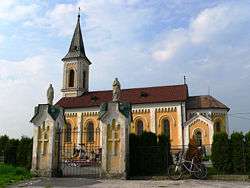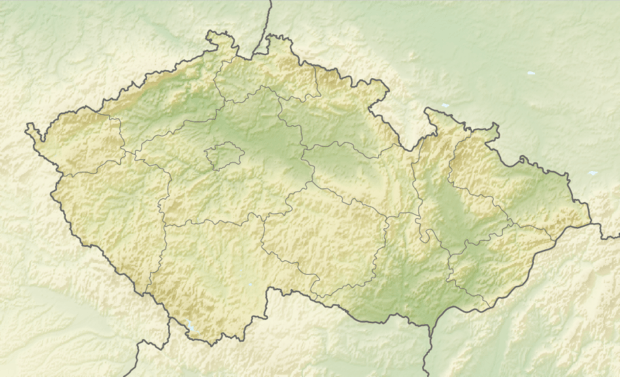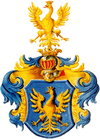Těrlicko
Těrlicko (Czech pronunciation: [ˈcɛrlɪtsko], locally: ![]()
![]()
Těrlicko Cierlicko | |
|---|---|
Village | |
 Saint Lawrence Church before renovation | |
 Flag  Coat of arms | |
 Těrlicko Location in the Czech Republic | |
| Coordinates: 49°44′54″N 18°30′1″E | |
| Country | Czech Republic |
| Region | Moravian-Silesian |
| District | Karviná |
| First mentioned | 1229 |
| Government | |
| • Mayor | Martin Polášek |
| Area | |
| • Total | 24.65 km2 (9.52 sq mi) |
| Elevation | 260 m (850 ft) |
| Population (2019-01-01[1]) | |
| • Total | 4,517 |
| • Density | 180/km2 (470/sq mi) |
| Time zone | UTC+1 (CET) |
| • Summer (DST) | UTC+2 (CEST) |
| Postal code | 735 42 |
| Website | www.terlicko.cz |
Administrative parts
The village is made up of three administrative sections (formerly independent villages): Dolní Těrlicko (Polish: Cierlicko Dolne), Horní Těrlicko (Cierlicko Górne), Hradiště (Grodziszcze). Among other parts of village there is also a former village of Kostelec (Kościelec).[3]
History
It was first mentioned in the document of Pope Gregory IX issued for Benedictine abbey in Tyniec in 1229 as Cierli(t)zko.[4][5]
Politically it belonged then to the Duchy of Opole and Racibórz and Castellany of Cieszyn, which was in 1290 formed in the process of feudal fragmentation of Poland and was ruled by a local branch of Piast dynasty. In 1327 the duchy became a fee of the Kingdom of Bohemia, which after 1526 became part of the Habsburg Monarchy.
The village probably became a seat of a Catholic parish prior to the 16th century, and also a church in the hamlet of Kostelec/Kościolec was built. After the 1540s Reformation prevailed in the Duchy of Teschen both were taken over by Lutherans. They were taken from them (as two from around fifty buildings) in the region by a special commission and given back to the Roman Catholic Church on 24 March 1654.[6]
In the 16th century the division into two parts developed: Dolní Těrlicko (first mentioned in 1598 as na dolnim Tierliczku) and Horní Těrlicko (first mentioned in 1613 as na hornim Tierliczku).[7]
The area changed hands many times over the centuries, until in 1731 it became the property of the Larisch-Mönnich noble family, last noble owners of the village. The Larisch family opened the first coal mine in Karwina in 1798, and the local villagers slowly gave up their farming way of life. The first coal miners were often forcibly compelled to work. In 1926 a new era for the village began; noble families could no longer own municipalities.
After Revolutions of 1848 in the Austrian Empire a modern municipal division was introduced in the re-established Austrian Silesia. The villages as a two separate municipalities were subscribed to the political and legal district of Cieszyn.
According to the censuses conducted in 1880, 1890, 1900 and 1910 the population of Dolní Těrlicko grew from 454 in 1880 to 617 in 1910 with a majority being native Polish-speakers (between 97.2% and 99.1%) accompanied by a few German-speaking persons (at most or 2.5% in 1890). In terms of religion in 1910 majority were Protestants (54.9%), followed by Roman Catholics (45.1%). In Horní Těrlicko the population dropped from 1452 in 1880 to 1390 in 1910 with a majority being native Polish-speakers (between 98.6% and 99.7%) accompanied by a few German-speakers (at most 10 or 0.7% in 1910) and Czech-speakers (at most 9 or 0.7% in 1910). In terms of religion in 1910 the majority were Roman Catholics (66.5%), followed by Lutherans (35.5%).[8] The villages were also traditionally inhabited by Silesian Lachs, speaking Cieszyn Silesian dialect.
After World War I, fall of Austria-Hungary, Polish–Czechoslovak War and the division of Cieszyn Silesia in 1920, the village, still divided into two municipalities, became part of Czechoslovakia.
On 11 September 1932, well-known Polish aviators Stanisław Wigura and Franciszek Żwirko died at Kostelec in a tragic plane crash. Two weeks before, they had won the most prestigious aviation competition in Europe—Le Challenge International Avions de Tourisme. A mausoleum was built on the site of the crash in 1935, and crosses were erected. The mausoleum was demolished by the Nazis in 1940. In 1950 a new monument, known as Żwirkowisko, was built which is there today. It is maintained by MK PZKO (Polish Cultural and Educational Union) Kościelec.
Following the Munich Agreement, in October 1938 together with the Zaolzie region they were annexed by Poland, administratively adjoined to Cieszyn County of Silesian Voivodeship.[9] They were then annexed by Nazi Germany at the beginning of World War II. After the war it was restored to Czechoslovakia.
After World War II the Těrlicko Dam was built on the Stonávka River, inundating 141 buildings, including many community buildings and a church. In 1964 Dolní Těrlicko and Horní Těrlicko were administratively joined to the village. Hradiště was joined in 1975.
The first school in the village was established in the 13th century by the Benedictines. In 1705 a wooden Catholic school was built, and in 1794 a new Catholic school was built. In 1852 a Protestant school was built. Classes were conducted in German and later in Polish. A Czech school was built in 1920.
There was a wooden Catholic church in the village. In 1769–1772 a new brick Baroque church was built, but it was destroyed during the dam's construction. There is also a St. Lawrence Church in Kostelec. When the original church building fell into decrepitude, a new one was built in its place in 1908. The Lutheran church in Těrlicko was built in 1966-1967 (the tower was built later).
Economy
Těrlicko was eventually transformed into a village with many tourist attractions. Many recreational centres were built. The village is a popular spot for water sports.
Notable sites

- Żwirkowisko. A monument to well-known Polish aviators Stanisław Wigura and Franciszek Żwirko who died in the village in a tragic plane crash on 11 September 1932.
- Pub Jaškovská krčma. The first mention about the pub is from 1268. It was located on an important historic trade route between Opava and Těšín (this route is today disrupted by the dam built in 20th century). The building got damaged by a fire in 1692 but was re-built shortly after the fire. After this reconstruction, the rebuilt structure is preserved till today. Inside the pub the original arches from 17th century can still be observed. Under the pub, there is the original cellar from 13th century. In the cellar, there was a secret passage that was used to escape from enemies. The pub was namely also used as fortress by highwaymen. Later, it was used, on the contrary, as a place to collect toll and a station for trade route guarding crew. In the second half of 20th century, the pub was used as a recreation facility. Since 1990s, it serves as a hotel and a restaurant.
Notable people
- Wacław Maciejowski (1792–1883), Polish historian
- Karol Kotula (1884–1968), Polish Lutheran bishop
Gallery
 Dom Polski Żwirki i Wigury (Polish House of Żwirko and Wigura), home of MK PZKO Kościelec
Dom Polski Żwirki i Wigury (Polish House of Żwirko and Wigura), home of MK PZKO Kościelec Żwirkowisko monument
Żwirkowisko monument Polish elementary school
Polish elementary school Roman-Catholic Church in Těrlicko-Kostelec
Roman-Catholic Church in Těrlicko-Kostelec- Lutheran church from 1960s
 Lutheran cemetery; in foreground grave of A. Bolek and E. Grünfeldová
Lutheran cemetery; in foreground grave of A. Bolek and E. Grünfeldová Orphanage
Orphanage
References
- "Population of municipalities of the Czech republic". Czech Statistical Office. Retrieved 2019-04-30.
- "2001 census data". Czech Statistical Office.
- Informace o obci Těrlicko
- Hosák et al. 1980, 583-584.
- Panic, Idzi (2010). Śląsk Cieszyński w średniowieczu (do 1528) [Cieszyn Silesia in Middle Ages (until 1528)] (in Polish). Cieszyn: Starostwo Powiatowe w Cieszynie. p. 286. ISBN 978-83-926929-3-5.
- Broda, Jan (1992). "Materiały do dziejów Kościoła ewangelickiego w Księstwie Cieszyńskim i Państwie Pszczyńskim w XVI i XVII wieku". Z historii Kościoła ewangelickiego na Śląsku Cieszyńskim (in Polish). Katowice: Dom Wydawniczy i Księgarski „Didache“. pp. 259–260. ISBN 83-85572-00-7.
- Mrózek, Robert (1984). Nazwy miejscowe dawnego Śląska Cieszyńskiego [Local names of former Cieszyn Silesia] (in Polish). Katowice: Uniwersytet Śląski w Katowicach. p. 52. ISSN 0208-6336.
- Piątkowski, Kazimierz (1918). Stosunki narodowościowe w Księstwie Cieszyńskiem (in Polish). Cieszyn: Macierz Szkolna Księstwa Cieszyńskiego. pp. 263, 281.
- "Ustawa z dnia 27 października 1938 r. o podziale administracyjnym i tymczasowej organizacji administracji na obszarze Ziem Odzyskanych Śląska Cieszyńskiego". Dziennik Ustaw Śląskich (in Polish). Katowice. nr 18/1938, poz. 35. 31 October 1938. Retrieved 1 July 2014.
- Cicha, Irena (2004). Stonawka od źródła do ujścia. Český Těšín: Regio. ISBN 80-239-3850-9.
- Hosák, Ladislav; Rudolf Šrámek (1980). Místní jména na Moravě a ve Slezsku II, M-Ž. Praha: Academia.
- Radłowska-Obrusnik, Martyna (28 August 2007). "Ani mogiła, ani pojednanie". Głos Ludu. p. 3.

